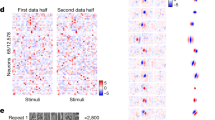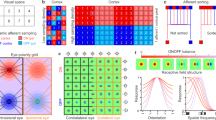Abstract
WE argue that cortical maps, such as those for ocular dominance, orientation and retinotopic position in primary visual cortex1, can be understood in terms of dimension-reducing mappings from many-dimensional parameter spaces to the surface of the cortex. The goal of these mappings is to preserve as far as possible neighbourhood relations in parameter space so that local computations in parameter space can be performed locally in the cortex. We have found that, in a simple case2, certain self-organizing models3,4 generate maps that are near-optimally local, in the sense that they come close to minimizing the neuronal wiring required for local operations. When these self-organizing models are applied to the task of simultaneously mapping retinotopic position and orientation, they produce maps with orientation vortices resembling those produced in primary visual cortex5. This approach also yields a new prediction, which is that the mapping of position in visual cortex will be distorted in the orientation fracture zones5
This is a preview of subscription content, access via your institution
Access options
Subscribe to this journal
Receive 51 print issues and online access
$199.00 per year
only $3.90 per issue
Buy this article
- Purchase on Springer Link
- Instant access to full article PDF
Prices may be subject to local taxes which are calculated during checkout
Similar content being viewed by others
References
Hubel, D. H. & Wiesel, T. N. Proc. R. Soc. B 198, 1–59 (1977).
Mitchison, G. J. & Durbin, R. M. SIAM J. alg. disc. Meth. 7, 571–582 (1986).
Durbin, R. M. & Willshaw, D. Nature 326, 689–691 (1987).
Kohonen, T. Self-organization and Associative Memory (Springer, Berlin, 1984).
Blasdel, G. G. & Salama, G. Nature 321, 579–585 (1986).
Mountcastle, V. B. J. Neurophysiol. 20, 408–434 (1957).
Kaas, J. H., Nelson, R. J., Sur, M. & Merzenich, M. M. in The Organization of the Cerebral Cortex (eds Schmitt, F. O., Worden, F. G., Adelman, G. & Denis, S. G.) 237–261 (MIT, Cambridge, Massachusetts, and London, 1981).
Suga, N. & O'Neill, W. E. Science 206, 351–353 (1979).
Cowey, A. Q. J. exp. Psychol. 31, 1–17 (1979).
Hata, Y., Tsumoto, T., Sato, H., Hagihara, K. & Tamura, H. Nature 335, 815–817 (1988).
Hubel, D. J., Wiesel, T. N. & LeVay, S. Phil. Trans. R. Soc. B278, 377–409 (1977).
Van der Loos, H. & Woolsey, T. A. Science 179, 395–397 (1973).
Merzenich, M. M. et al. J. comp. Neurol. 224, 591–605 (1984).
Stryker, M. P. & Harris, W. A. J. Neurosci. 6, 2117–2133 (1986).
Ritter, H. & Schulten, K. Biol. Cybern. 54, 99–106 (1986).
Swindale, N. V. Proc. R. Soc. B215, 211–230 (1982).
Hubel, D. J. & Wiesel, T. N. J. Physiol. 195, 215–243 (1968).
Wiesel, T. N. & Hubel, D. H. J. comp. Neurol. 158, 307–318 (1974).
Linsker, R. Proc. natn. Acad Sci. U.S.A. 83, 8390–8394 (1986).
Miller, K. D., Keller, J. B. & Stryker, M. P. Science 245, 605–615 (1989).
Author information
Authors and Affiliations
Rights and permissions
About this article
Cite this article
Durbin, R., Mitchison, G. A dimension reduction framework for understanding cortical maps. Nature 343, 644–647 (1990). https://doi.org/10.1038/343644a0
Received:
Accepted:
Issue Date:
DOI: https://doi.org/10.1038/343644a0
This article is cited by
-
On the relationship between maps and domains in inferotemporal cortex
Nature Reviews Neuroscience (2021)
-
Modeling Axonal Plasticity in Artificial Neural Networks
Neural Processing Letters (2021)
-
Correction to: Modeling Axonal Plasticity in Artificial Neural Networks
Neural Processing Letters (2021)
-
A network of topographic numerosity maps in human association cortex
Nature Human Behaviour (2017)
-
Hand use predicts the structure of representations in sensorimotor cortex
Nature Neuroscience (2015)
Comments
By submitting a comment you agree to abide by our Terms and Community Guidelines. If you find something abusive or that does not comply with our terms or guidelines please flag it as inappropriate.



